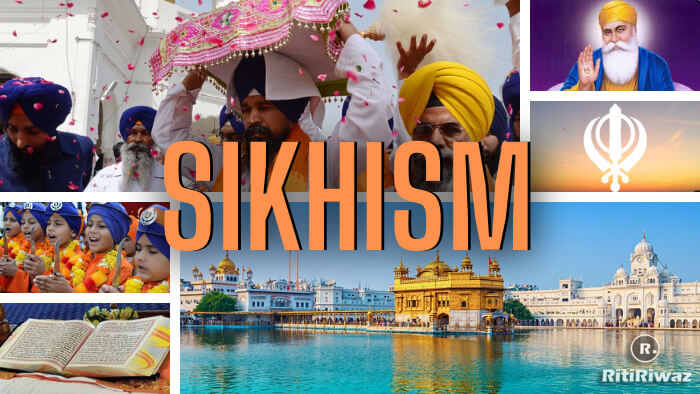Sikhism – The Youngest Religion

Sikhism is the religion of the Sikh which was founded by Guru Nanak in the 15th Century CE as an answer to the two major religions in India Hinduism and Islam. The word Sikh comes from the Punjabi Language which means ‘someone who learns ‘, ‘a disciple ‘. Sikhs are the disciples of God who follow the writings and teachings of the Ten Sikh Gurus.
Sikhism is a practical religion. It does not consist of a certain set of beliefs or mere words. Religion does not imply wandering to shrines and tombs or following austerities of Yogis. Sikhism is a way of life, something to be lived according to a pattern. Its main virtue is simplicity. There is no supernaturalism or mythology on which it rests. It does not believe in devils or angels or heavenly spirits.
Sikhs use many names to refer to God, the most common name used is Waheguru which means wonderful Lord, the Destroyer of Darkness. A Sikh also believes that God is shapeless, timeless, and sightless and that before creation, all that existed was God and his Hukum (will or order). They use the numeral 1 to signify the universality of God. Guru Nanak said that God is omnipresent and visible everywhere to the spiritually awakened. He stressed that God must be seen from the heart of a human being; meaning devotees must meditate to progress towards enlightenment.
The Origin of Sikhism
Sikhism is one of the world’s youngest religion, was founded only 500 years ago. It is a monotheistic religion that originated in the Indian province of Punjab (now part of the undivided Punjab which includes part of present-day Pakistan and portions of Afghanistan). Guru Nanak who was born in 1469 was the founder of the Sikh religion. He preached a message of love and understanding and criticized the blind rituals of the Hindus and Muslims. For many years he traveled as a seeker of truth, visiting many Hindu religious sites, as well as Mecca and Medina. Coming from a region that had been historically Hindu but was subjected to Islamic rule at the time of his birth, Nanak sought peace by combining the values of Hinduism and Islam. He teaches his direct revelation in the form of hymns that are still cherished and sung in the Sikh community. They teach that religion consists of being mindful of God, meditating on God’s name, and reflecting God in one’s life.
Guru Nanak passed on his leadership of the Sikhs and his enlightened spirit to nine successive Gurus. The final living Guru, Guru Gobind Singh was the last living Guru who died in 1708. He pronounced the end of the lineage of Gurus in a physical body and vested final authority in the Sikh community and in the Scriptures, which are called Guru Granth Sahib.
The Ten Gurus of Sikhism and their divine attribute
- First Guru Guru Nanak Sahib – Humility
- Second Guru Guru Angad Sahib – Obedience
- Third Guru Guru Amardas Sahib – Equality
- Fourth Guru Guru Ramdass Sahib – Service
- Fifth Guru Guru Arjan Sahib – Self-Sacrifice
- Sixth Guru Guru Hargobind Sahib – Justice
- Seventh Guru Guru Har Rai Sahib – Mercy
- Eighth Guru Guru Harkrishan Sahib – Purity
- Ninth Guru Guru Tegh Bahadur Sahib – Tranquility
- Tenth Guru Guru Gobind Singh Sahib – Royal Courage
In his lifetime Guru Gobind Singh established a new voluntary order of Sikhs, the Khalsa brotherhood (meaning ‘The Pure’), soldier-saints. The Khalsa upheld the highest Sikh virtues and fought many battles to fight injustice and preserve Sikhism. The Khalsa are Sikhs who have undergone the baptism ceremony initiated by Guru Gobind Singh and who follow a Code of Conduct and wear five physical symbols of the brotherhood. One of the more noticeable symbols is the uncut hair which is kept in a bun and covered with a turban.
Before his death, Guru Gobind Singh declared that the Sikhs no longer needed a living Guru and appointed his successor as the Sikh Holy Book the Guru Granth Sahib. Guru Gobind Singh felt that all the wisdom needed by the Sikhs for guidance in their daily lives could be found in the Guru Granth Sahib, the Eternal Guru of the Sikhs. The Guru Granth Sahib is unique in the world of religious scriptures because not only is it accorded the status of being the head of the Sikh religion, but besides the poetry of the Gurus, it also contains the writings of Hindu and Muslim Saints.
Sikhs only have custodians of the Guru Granth Sahib (granthi), and any Sikh is free to read the Guru Granth Sahib in the Gurdwara (Sikh Temple) or in their home. All people of all religions are welcome to the Gurdwara. A free community kitchen can be found at every Gurdwara which serves meals to all, community service is an important aspect of Sikhism. The most important religious center for the Sikhs is Harmandir Sahib (The Golden Temple) at Amritsar in Punjab. As the Vatican is to Catholics and Mecca to the Muslims so is The Golden Temple to Sikhs.
Philosophy and Beliefs
There is only One God. He is the same God for all people of all religions.
The soul goes through cycles of births and deaths before it reaches the human form. The goal of our life is to lead an exemplary existence so that one may merge with God. Sikhs should always remember God and practice living a virtuous life according to the writings in the Guru Granth Sahib.
The true path to achieving salvation does not require renunciation of the world or celibacy but living the life of a householder and avoiding worldly temptation and sins.
Sikhism condemns such rituals as fasting, visiting places of pilgrimage, superstitions, worship of the dead, idol worship, etc.
Sikhism preaches that people of different races, religions, or sex are all equal in the eyes of God. Sikhism teaches the full equality of men and women.
The Moola Mantra, which begins the Guru Granth Sahib, outlines the beliefs of Sikhs:
- There is One God.
- He
- Is Supreme Truth
- Is without fear.
- Is Timeless, Eternal
- Is not born, so
- He does not die to be reborn.
- Self-illumined,
- By Guru’s grace
- He is revealed to the human soul.
- The truth was in the beginning,
- and throughout the ages.
- Truth is now and ever will be.
Guru Nanak accepted some traditional beliefs of Hinduism, such as the cyclical nature of time (the earth endures endless cycles of creation and destruction), and reincarnation. “Haumai,” or self-centeredness, caused by greed, lust, pride, anger, and attachment to the passing things of earthly life, is believed by Sikhs to be the source of all evil. It is this self-centeredness that produces karma and the endless cycles of rebirth.
Sikhs believe that the purpose of human life is to experience spiritual union with the Divine – “to merge with Ultimate Reality like a drop of water merges with the ocean and becomes one with it”, rather than to attain salvation or a heavenly abode like Paradise. This union with God is enlightenment – release from reincarnation, and any person can attain it. Sikhism believes in full participation in human life, work, and family. Responsibility in these areas is a way to serve and seek God. Sikhs understand God to be both immanent and transcendent, encouraging everyone to aspire to become God-like while living.
Sikhism believes in the equality of all persons regardless of gender. Guru Gobind Singh, the tenth guru, declared that all followers should change their last names: Singh (or lion) for men, and Kaur (or princess) for women, indicating universal equality.
Sikhism Symbol

The symbol most often associated with Sikhism is called the Khanda. It is composed of five parts, which have been interpreted to symbolize the unity of God, God’s concern for justice and truth, and God’s spiritual power.
Sikh young people who have been initiated, and are therefore observant of the five K’s, have been allowed by the Ninth Circuit Court of Appeals to carry their kirpan, the steel dagger, to school under certain conditions. Although all public schools must adhere to a “no weapons” policy, Sikh youth may wear the kirpan so long as it is sewn or bolted into the sheath so that it cannot be removed. In some of these cases, it is also worn beneath the clothing.






